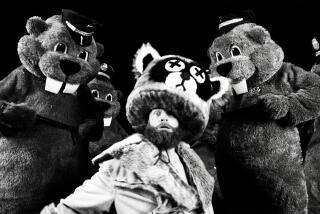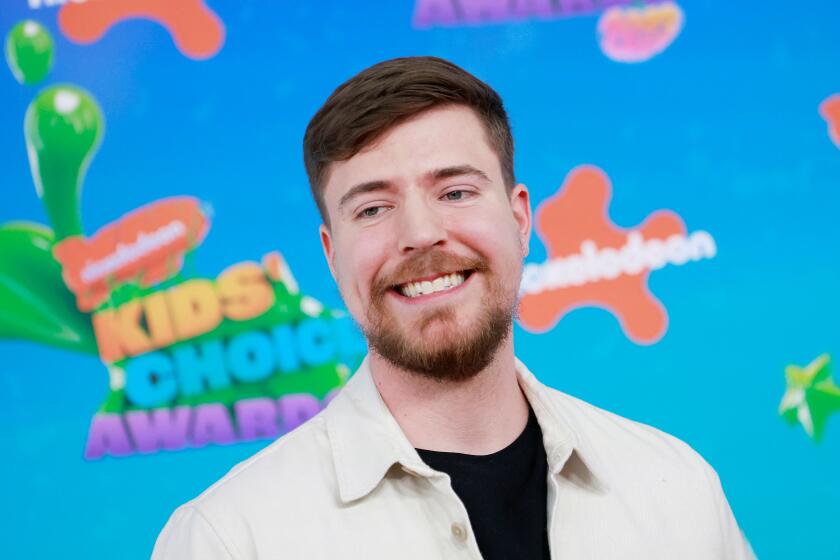Critic’s Pick: TV Picks: ‘Of Oz the Wizard,’ ‘Autism in Love,’ ‘Doc Martin’
“Of Oz the Wizard” (Vimeo). Matt Bucy created this alphabetical reshuffling of “The Wizard of Oz,” from “a” to “zipper,” in 2004, but for reasons known only to himself, refrained from sharing it with the rest of the world until last week. The dozen intervening years have not made it seem any less fresh or modern, even as recombinant culture continued to grow and grow familiar. (See also “Star Wars Wars,” for a recent, related example.)
It’s one of those ideas whose strength resides in its simplicity; even as a concept, it has a certain daft power, like a page out of Yoko Ono’s “Grapefruit,” whose realization may be possible only in the mind. But being possible in the world, it is better to have the real thing. The genius is in the instructions — but the execution, both in the doing and what has been done — is what we’re here to admire. As in certain compositions by John Cage, to keep this discussion arty, the process is both randomized and ordered. Watching “Of Oz” is something like watching shuffled cards fall out of a deck in a game of solitaire or war. Listening to it is reminiscent of the glitch music of the late 1990s.
After opening credits that also are alphabetically reordered (“by directed Fleming Victor”), the film begins to cycle through itself, word by word — every utterance of “a,” of which there are many, through to the single saying “zipper.” (Most words appear once, each accounting for a handful of frames; the exhaled “hhh,” most often produced by Judy Garland, offers perhaps the most complete trip through the movie.)
But because “Oz” is so firmly ingrained in memory — my memory, anyway, and I do hope yours — and so clearly structured and so visually strong, you always know where you are, even when the results are at their most fragmented. (When a word is followed by a passage of wordlessness, the scene plays out until the next word comes along; it builds in some breathing room.)
Some words pop, of course — “Kansas,” “Dorothy,” “Wizard,” “Toto,”
“Munchkin” — but a musical syllable like “be” can produce very effective results, with each appearance taking on its own particular timbre and emphasis, each making a little song, sometimes borrowing pitch from the songs already in the film.
Images flash back, almost stroboscopic at times, rebuilding the film as if out of memory. Whatever Bucy, whose vocations include cinematography, architecture and software design, intended, “Of Oz” is a deep well, a meditation on language, film and history you wouldn’t be surprised to see signed Jean-Luc Godard, except he didn’t think of it first. Super fun, too.
“Autism in Love” (PBS, Monday). Matt Fuller’s three-streamed film, shown under the umbrella of the documentary series “Independent Lens,” looks at love and loneliness as experienced by those “on the spectrum.” If it’s heartbreaking at times, its attitude to its subjects and its subject, is never condescending or pathetic. And at other times, it is as romantic as anything imagined by William Shakespeare or Barbara Cartland, and the tears you’ll cry in the end will be ones of happiness. There is no obvious agenda to the film, other than to demonstrate, simply by showing, that the title is not self-contradictory.
Fuller focuses on four characters in three cities, representing a range of ages, abilities and challenges — colored by autism, but not specific to it. Lenny, who has learning deficits and looks to be in his early twenties, lives with his mother in Los Angeles; he’s expressive, stubborn and often angry — “smart enough to know that he’s different,” says his mother, “and he doesn’t like it.”
Stephen, a St. Paul, Minn., postal worker in late middle age, most closely fits the stereotypical image of an autistic person: his affect pleasant, his speech limited as if to use too many words to answer a question were to spend capital he’ll never get back. His wife, Gita, also autistic but more verbal and self-reflective, is undergoing chemotherapy for ovarian cancer. (“What did you say to her when you first met her?” Fuller asks Stephen. “Hello,” Stephen replies.)
Finally, there are the attractive, high-functioning Dave and Lindsey, a couple for eight years (and the subject in 2009 of a Glamour magazine article), who live together and sometimes talk about marriage. Dave, a meteorologist, has a formula for determining the worth of a relationship (l + p + 2t, where l is looks, p is personality, and t is “how they treat you”), while Lindsey, who plays piano, is more “artistic.” Articulate and elegant, seemingly self-possessed (though she credits much of that to being “a good actress”) she’s the film’s star, at once the viewer’s guide to a different way of being and a reminder that all ways of being are different and, despite differences, in many ways same. Her description of “our particular routine and rigidities and our particular comfort zones we’re so fixated on that it’s sometimes difficult to communicate with each other” should be familiar to anyone who’s shared a domestic space. “It’s a very good question whether someone can love you without truly understanding you,” she says. “I still think it’s absolutely possible, yeah.”
“Doc Martin” (KCET, Thursdays). Previously available here only via Acorn media, the seventh season of Martin Clunes’ lovely comedy of frustration, makes its American public broadcasting debut this month. You’ll find it locally beginning Thursday on KCET, where the series has been a staple of that station’s post-PBS programming. (It’s a longtime favorite of this department: You can read my interviews with producer-star Clunes here and here.)
Fans will be primed and pumped, but to oversimplify for beginners: Clunes plays Martin Ellingham, a brilliant London surgeon who, having developed a sudden fear of blood, relocates to the Cornwall fishing village where he spent summers as a child. His relationship to the town (called Portwenn in the show and Port Isaac in the world) is complicated by a complete lack of social skills or interest — he is both a figure of authority, as someone who saves lives on a regular basis, and a figure of fun, as a person pathologically stiff-necked.
This doesn’t keep the show from being very much a (difficult) love story, between Martin and Carolyn Catz’s schoolteacher Louisa. Over the seasons, they’ve crept from attraction to parenthood to marriage (in that order), and now, in the latest season, to therapy. While very much a familiar sort of construction — “Northern Exposure” is a cousin, with its grumbling doctor, eccentric locals and sense of beautiful place — it is exquisitely made, funny and maddening at once and always nice to look at. (The setting is a character, too.) With the colorful support of Ian McNeice as Bert, once a plumber, most lately a failing restaurateur, now with a new dodgy project; Joe Absolom as his son, Al, partnering with Martin’s psychiatrist Aunt Ruth (Eileen Atkins, DBE) in a bed and breakfast; Jessica Ransom as Martin’s underappreciated receptionist (following in the estimable footsteps of Judy Punch and Katherine Parkinson) and other well-cast regulars, semi-regulars and guests.
Follow Robert Lloyd on Twitter @LATimesTVLloyd
More to Read
The complete guide to home viewing
Get Screen Gab for everything about the TV shows and streaming movies everyone’s talking about.
You may occasionally receive promotional content from the Los Angeles Times.







